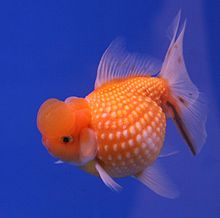 | |
| Country of origin | China and Japan |
|---|---|
| Type | Fantailed |
| Classification | |
| BAS | |
The Pearlscale (or Chinshurin in Japanese) is a spherical-bodied fancy goldfish with doubled finnage similar to the fantail. [1] [2]
 | |
| Country of origin | China and Japan |
|---|---|
| Type | Fantailed |
| Classification | |
| BAS | |
The Pearlscale (or Chinshurin in Japanese) is a spherical-bodied fancy goldfish with doubled finnage similar to the fantail. [1] [2]
The characteristic feature of the Pearlscale is its thick, domed scales with pearl-like appearance. [1] [3] Its body is round and similar to a golf ball. The finnage may be long or short. Pearlscales can reach up to 8 inches long and grow up as large as an orange. [3] Pearlscale goldfish are susceptible to swimbladder disorders which affect the ability to maintain normal position in the water. This is attributed to the selective breeding process of fancy goldfish to achieve particular body forms, such as that of the Pearlscale's roundness, which results in the alteration of the appearance of the shape and function of the swimbladder. [1] The Pearlscale can also known as the Ping Pong Pearlscale and Golfball Pearlscale.
The Pearlscale standard is as follows:
The fish should be bright and alert and displaying well developed domed scales all over the body area. The body should be short and rounded (not elongated). The caudal fin should be held high without signs of drooping and well divided. Quality fish will have high color intensity extending into the fins. [4]
Pearlscales come in every fancy goldfish color variety. [3]
The color may be metallic (ideally self-colored or variegated in a pleasing pattern and similar on each side), orange or calico. The Pearlscale may also be fully black in color. Metallic colors should appear as burnished metal, extending into the fins. Calico fish should have a blue background with patches of violet, red, orange, yellow and brown, spotted with black.

Pearlscales are found without headgrowth (wen), with Oranda-like headgrowth, or with two large bubble domes. The bubble-domed Pearlscales are known as High-head Pearlscale, Crown Pearlscale or Hama Nishiki. [3]
Like many fancy goldfish, Pearlscales are egg-shaped with internal organs crowded in a compacted body, therefore overfeeding should be avoided. Pearlscales are very sensitive to cold water and should not be exposed to temperatures below 55 °F (13 °C). They are also quite vulnerable to pH changes and should not be exposed for long periods to overly acidic or alkaline environments. [1]
The breeding and marketing of fancy goldfish with extreme mutations is sometimes seen as cruel practice by fish keepers and animal rights activists. Because the Pearlscale Goldfish has been bred to such a spherical shape, it may experience problems with its spine and internal organs, reducing its quality of life and longevity. [5]
Single-tailed, common goldfish varieties such as comets are less highly bred and tend to experience less health problems and a greater lifespan than fancy varieties.
Shubunkins are a hardy, single-tailed goldfish with nacreous scales and a pattern known as calico. The Shubunkins are of Japanese origin.

Calico goldfish are goldfish of any breed that have a type of scale that is intermediate between the metallic type of scales and the transparent type. These scales have a slight sheen that produces a pearly appearance. The name "calico goldfish" came about because the first fish that were introduced with this type of scales had a mottled calico pattern with several colours.

The Bubble Eye is a small variety of fancy goldfish with upward-pointing eyes that are accompanied by two large fluid-filled sacs. It is a dorsal-less fish – good specimens will have a clean back and eye bubbles that match in color and size. Their bubbles are quite delicate, so the fish should be kept separately from boisterous types, as well as sharp tank decor. Although the bubbles will regrow if punctured, an injury could leave the fish prone to infections. The bubbles can disadvantage the fish as it is not a strong swimmer, with a seemingly low bobbing head at times; bubbles are infamous for being sucked into filters and siphons in an aquarium.

The comet or comet-tailed goldfish is a single-tailed goldfish bred in the United States. It is similar to the common goldfish, except slightly smaller and slimmer, and is mainly distinguished by its long deeply forked tail. Comet goldfish tend to have a diverse variety of colors, unlike the common goldfish.

The telescope, telescope goldfish or telescope eye is a goldfish characterised by its protruding eyes. It was first developed in the early 1700s in China, where the trait was referred to as dragon eyes.

The ryukin is a short deep-bodied fancy goldfish with a characteristic hump in the shoulder region.

An oranda is a breed of goldfish characterized by a prominent bubble-like "hood" on the head. The headgrowth or hood may be a prominent growth on the top of the head or may encase the entire face except the mouth.
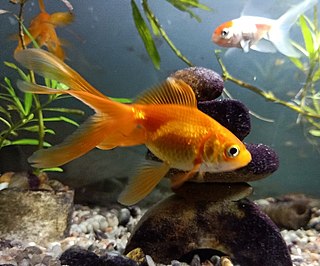
The Fantail is a goldfish that possesses an egg-shaped body, a high dorsal fin, a long quadruple caudal fin, and no shoulder hump. It is similar to the Ryukin, and is relatively common in western countries. The Fantail Goldfish is the base for many fancy goldfish species.

The lionhead is a hooded variety of fancy goldfish. This fish is the precursor to the ranchu.
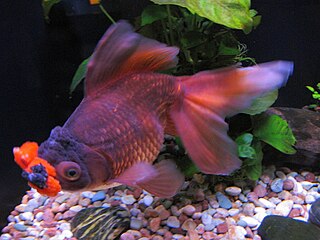
Pompoms, pompon or hana fusa are a type of fancy goldfish that have bundles of loose fleshy outgrowths between the nostrils, on each side of the head.

The Ranchu is a hooded variety of goldfish native to Japan. It is referred to as the 'king of goldfish" by the Japanese. Maruko more commonly refers to the egg-fish goldfish.
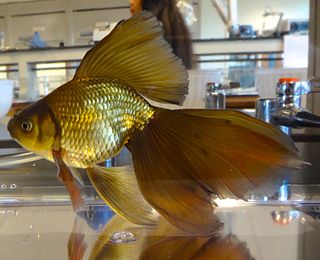
The veiltail is a type of goldfish known for its extra-long, flowing double tail and high sail-like dorsal fin.
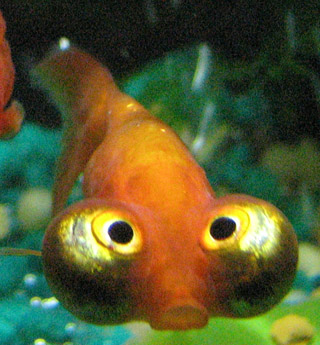
Celestial eye goldfish or Choutengan is a double-tailed breed of fancy goldfish that has a breed-defining pair of telescope eyes which are turned upwards, pupils gazing skyward. When the fry hatch, the eyes of young Celestials are normal but gradually protrude sideways, as in the telescope eye goldfish, but unlike the telescope, which has eyes facing outwards on each side, the eyes of the celestial eye turns strictly upwards within a period of six months of development. This process is entirely governed by genetics, though early sources perpetuated the myth that the fish were bred and kept in narrow-necked clay jars and the eyes turned upwards seeking the limited source of light.
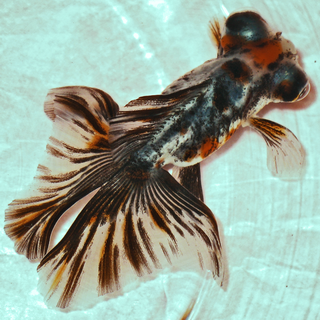
The Butterfly telescope goldfish is a variant of telescope goldfish that is distinguished by the butterfly-shaped caudal fins when viewed from above. It is a variety that has only recently been deemed a major lineage by a few published works. The tail conformation is commonly bred into the telescope eye goldfish, the term "butterfly tail" is just short for the many names this variety has such as Butterfly Tail Demekin, Butterfly Tail Black Moor and Top view Telescope (TVT), and many other goldfish varieties.
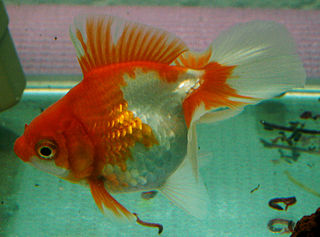
The Tosakin (土佐金) or curly fantail goldfish is a distinctive breed of goldfish with a large tail fin that spreads out horizontally behind the fish. Though technically a divided tail, the two halves are attached at the center/middle forming a single fin.
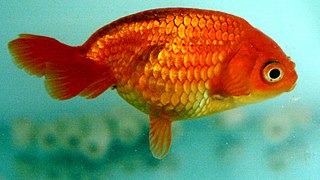
The egg fish goldfish is a fancy goldfish breed which lacks a dorsal fin and has a pronounced egg-shaped body. They look like ranchu but lack the "hood" or wen commonly found on ranchu goldfish, they also tend to have longer bodies.

The Curled-gill or Reversed-gill goldfish is another uncommon variety of fancy goldfish that has been developed by specialist enthusiasts. It owes its name from the out-turned appearance of its gill covers. This fish resembles a Ryukin. For the appearance of this goldfish, it has a fantail-shaped body with long finnage all round as well as a deeply forked tail; the color is typically metallic orange.

The goldfish is a freshwater fish in the family Cyprinidae of order Cypriniformes. It is commonly kept as a pet in indoor aquariums, and is one of the most popular aquarium fish. Goldfish released into the wild have become an invasive pest in parts of North America.
The wakin is an intermediate twin tailed goldfish variety that has been originated from Japan. It is believed the wakin gave rise to fancy twin-tailed goldfish, including the ryukin, ranchu, oranda, fantail pearlscale, and many more twin-tailed goldfish. It is also the second oldest variety, developed from the common goldfish.